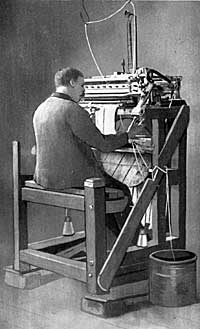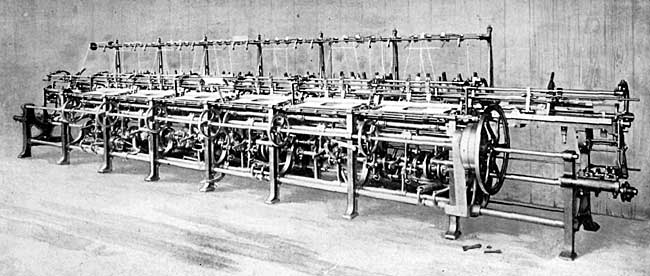CHAPTER LXVIII.
THE STOCKING FRAME

The Stocking Frame.
To Woodborough and Calverton belong the honour of having produced the man who largely affected our district for good, for not only has the stocking frame been the means of support for many thousands of persons in the City and the villages, but the lace machine, that has been the means of thousands more obtaining thereby a livelihood, is but a modification of, and improvement on, the stocking frame, so that a vast number of persons may thank William Lee for his invention.
Lee. The Rev. William Lee, M.A., St. John's College, Cambridge, was born at Woodborough, and when curate of Calverton, about 1589, he invented the machine. The tradition is that he was in love with a young woman at Calverton, but that whenever he went to visit her she was much occupied with her knitting, which so greatly annoyed him that he determined to invent a machine that would supersede knitting. Another account is that he, being a poor curate and having a large family, his wife was obliged to knit in order to increase their income, and that both he and the elder children joined in the knitting. There are various other reports and traditions. Let us hope the first account is the true one, because it would furnish an example for young men, showing how a part of their time of courtship may be spent in mechanical inventions for the good of the race! Poor Lee, like many other inventors, obtained little benefit from his invention. He went to London, and he or his brother worked the machine before Queen Elizabeth, whose patronage he sought, but did not obtain, for the Queen was fearful the invention would injure the poor people who obtained their living by knitting, and he returned to Calverton mortified and downcast. Still he persevered in making further improvements. Richard Parkyns, Esq., M.P. for Nottingham, who had obtained the introduction to the Queen, now introduced Lee to the French Ambassador, who communicated the business to his Sovereign, Henry IV. of France, and that monarch invited Lee over to France with the promise of honours and rewards. He, with his family and nine workmen, went and took his machinery to Rouen, in Normandy, where he worked to the great satisfaction of the King, and the trade might have been lost to England; but suddenly the King was murdered; Mr. Lee's creditors thereupon came down upon him, sold the machinery, and stripped him of everything. He went to Paris, where, obtaining no relief, his spirits sank, and he died of a broken heart.
"Full many a gem of purest ray serene
The dark, unfathomed caves of ocean bear;
Full many a flower is born to blush unseen
And waste its sweetness on the desert air."
The workmen returned, and after a time a Company of Framework Knitters was established in London. A very long petition is extant that was presented to "His Highness the Lord Protector" Cromwell, setting forth the attempts that had been made to establish the trade in France, Venice, and Amsterdam, and begging for his patronage, but the petitioners failed to effect their object. The trade, however, gradually spread in regard to locality, and increased in regard to bulk, so that the competition became very keen, and wages became very poor. Many improvements were made, and patents taken out by succeeding workers.
Strutt. The first great development, however, of Lee's machine "took place in 1758, when Mr. Jedediah Strutt, of Belper, added another set of needles to the machine, and produced a 'rib' fabric which under the name of the 'Derby rib' became very popular."
Great developments and improvements were made by succeeding members of the Strutt family, and Mr. William Felkin, the author of Machine wrought Hosiery and Lace, cannot help observing "how strange are the contrasted events of human life when one reflects on the melancholy fate of Lee, of Elizabeth's coldness, and his sad exile and lonely death; and then turning to see bright and usefully happy days, the long and tranquil career of Jedediah Strutt, to whom, in only the third generation, there follows in the person of Edward, Mr. Strutt's grandson, the member of the House of Commons,* the Minister, and at length the Peer. It was in 1856 that Queen Victoria, as a mark of the interest she took in the manufacturing industry of the country, having observed that this important element of national wealth had not been suitably represented in the Upper House, expressed through Lord Palmerston her intention of conferring on Edward Strutt, Esq., of Kingston Hall, Nottinghamshire, the honour of the peerage. He paid a graceful compliment to the town of Belper, as the scene of the commercial enterprise and prosperity of his family, by adopting its name for his title."
The adaptation of the rotary motion to the stocking frame was first effected in Nottingham in 1769 by Samuel Wise, a clockmaker, who took out a patent for changing the hand frame into a rotary.
Luddites. We must go back to dark days. In 1811 there was a great depression in the hosiery trade, and many workmen had no means of subsistence. Rent, sometimes excessive, charged for frames when let out to workmen was also burdensome, and helped to increase suffering and discontent. On March 11th, there was a meeting of the framework-knitters from the villages, when many threats of vengeance were made against some of the manufacturers who had reduced the prices for making stockings. The military, however, appeared, and the crowd was broken up. That same night sixty-three frames were broken at Arnold, and during the next few weeks two hundred more machines were broken. The evil increased and extended so much that one thousand stocking frames, and a large number of lace machines, were destroyed in our County, and many others in the neighbouring counties. These "Luddite" outrages continued from 1811 to 1816 at Bulwell, Arnold, Sutton, Mansfield, Hucknall, Basford, Sneinton, Nottingham, and elsewhere, by four separate gangs. Farm houses were plundered. Public houses were closed at ten p.m.; London police magistrates and officers were sent down to assist in discovering the ringleaders, a secret committee was formed, and large funds were provided; a Royal Proclamation was issued, offering £50 reward for the apprehension of the offenders; a reward of £600 was offered for the discovery of men who shot a manufacturer—but all without avail; and an Act of Parliament was in 1812 passed involving the penalty of death for breaking a stocking or lace frame. The Act continued in force two years.
Poor Stockingers. The distress was such that in Nottingham, on January 30th, 1812, four thousand two hundred and forty-eight families, consisting of fifteen thousand three hundred and forty individuals, were relieved out of the poor rates, being nearly one half of the population. In 1817 The Nottingham Review reports an appeal from the framework knitters at Hoveringham, which stated that their average earnings were only 9s. per week, and that after deductions had been made for frame rent, etc., only 6s. 6d. was left, and when their house rent, coal, candles, etc., were paid for, only 2s. remained, which for a man, wife, and say two children, left only 6d. per head. Poor fellows! The price of wheat in Nottingham was then from 80s. to 122s. per quarter, and foreign wheat from 106s. to 130s., being three to four times its present price.
As showing how the stocking making had located itself in the villages, White's Directory for 1844 gives the number of frames at Calverton as four hundred. At present there are probably a hundred, but only fifty worked. Mr. Coggan has, however, introduced steam worked machinery, which gives the workers great advantages.
Lord Byron, living in the locality, and seeing the evils occasioned, wrote his "Song for the Luddites," commencing—
"As the Liberty lads o'er the sea
Bought their freedom, and cheaply, with blood."
In a maiden speech in the House of Lords, he, while forcibly describing the terrible state of affairs, opposed the death penalty.
Improvements. An authority describing the improvements after Mr. Strutt, says: "The next great advance came about a century later, when in 1845 what is known as the ' circular loop wheel' frame was introduced for the trade in Nottingham. Since that time improvements have followed very fast, until to-day the different types of hosiery machines are numbered almost by the hundred. An expert woman with needles could knit one hundred loops a minute, whereas there are now machines which can knit half a million or more loops in the same time."
Cotton. Valuable patent machines were invented by Mr. W. Cotton, of Loughborough, about 1866, which produced underwear, stockings, half hose, and children's socks in large quantities. These machines are not only used for the making of plain and ribbed goods, but are adapted to produce all kinds of fancy, striped and check patterns, and fancy lace goods in endless variety of designs. For the making of the latter, the jacquard machine has been adapted.
In circular machines for producing what are called "cut" garments, great improvements have of late years been made by English, Continental, and American builders, while what are known as seamless machines have been built in immense numbers, supplying hose and half hose in vast and constantly increasing quantities.
It has been the introduction of these patent fashioning frames, along with the circular and the seamless machines, which has done more than anything else to sweep away the old-fashioned hand frames, and gather the hosiery operatives into factories, of which so many have been built during the last thirty years in this and the neighbouring counties of Leicester and Derby.
Morleys. Turning from the machine to the article made, I think it desirable to give the following extract from "English Hosiery Manufacture," by Arthur Grey, in The Business Man's Magazine, August, 1907: "This account of the hosiery trade would be very incomplete if some reference was not made to the founders of the great hosiery house of Messrs. I. & R. Morley, Wood Street, E.C., and elsewhere. John and Richard Morley were two brothers, whose ancestors had for some time lived at Sneinton Old Manor House, near Nottingham, and farmed the adjoining land. At that time Sneinton was a pretty old-world village, abounding in quaint thatched cottages, sweet-smelling old-fashioned gardens, and many rocky caves . . . . . It was somewhere about the middle of the eighteenth century when John and Richard were born. When they grew up they continued the business of the farm, and at the same time engaged in the extending hosiery trade. The brothers could see that the latter had great possibilities in it, and they decided to give the trade more attention. As London was usually the centre aimed at, it was arranged that John should go to the City, open a small warehouse there, and Richard should be at the manufacturing end, and keep his brother well supplied with goods. The style of the partnership was 'I. & R. Morley,' which is identical with the name of the firm to-day. The partners were shrewd business men, and of strict integrity. They strove to produce the best goods that could be made, and spared no pains, time or expense in making their goods thoroughly reliable. The fame of their goods soon spread, orders came in, the small warehouse speedily became too small. Milk Street, E.C., was exchanged for Wood Street, where premises after premises were absorbed, until there is now that immense block which dominates Wood Street, and has large branches elsewhere. The business at Nottingham had also increased, branch manufactories had to be established at many other places to cope with the Wood Street demand. From these two brothers has sprung the huge concern known all over the world as 'Morley's.'"
The statue of Mr. Samuel Morley, erected by public subscription in 1888, stands in Parliament Street, Nottingham, and he is there very properly described as "Member of Parliament, Merchant, Philanthropist, Friend of Children, Social Reformer, Christian Citizen." One of his sons, the Right Hon. Arnold Morley, was M.P. for East Nottingham, and became Postmaster-General, and another son is a Governor of the Bank of England.
Mr. William Lee, J.P., a lineal descendant of the Rev. William Lee, has recently (February, 1908) departed from us, he being sixty-seven years of age. He was one of the Magistrates of the City, was born at Mansfield, apprenticed at the Meadow Foundry there, was an able mechanical engineer, whose word was his bond, a man of energy and principle. He was for thirty years the Superintendent of the Queen's Walk Congregational Sunday School. He became President of the Nottingham and Notts. Band of Hope Union. For fifty-seven years he was a zealous teetotaler, and his efforts were always in the direction of social reform.

Modern hosiery machine.
* Mr. Strutt was M.P. for Nottingham in 1852. I have a distinct recollection of his portly figure on the election platform.
